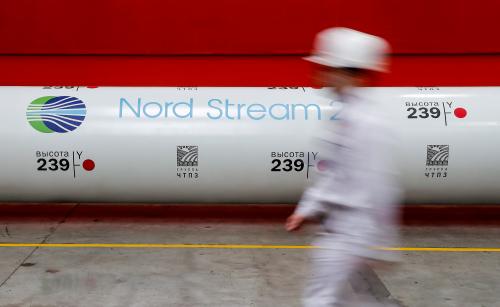President Joe Biden will hold a secure video call with Russian President Vladimir Putin December 7 against the backdrop of a menacing Russian military build-up near Ukraine. U.S. intelligence believes the Russians may amass 175,000 troops near its western neighbor early in 2022.
Does Putin intend to invade Ukraine? He could be bluffing. In April, the Russian army deployed a large force near Ukraine but did not act. On the other hand, given the scale of ongoing military preparations and the hostile rhetoric pouring out of Moscow, Putin may mean it this time.
It is also possible that Putin has not yet made a decision. He likes options and might hope the threat of force will secure concessions from Kyiv toward settling the simmering conflict in Donbas in eastern Ukraine on Moscow’s terms. In any case, the Biden-Putin conversation may offer one of the last best chances to affect Kremlin calculations of the costs of an assault on Ukraine.
Biden has said he would make it “very, very difficult” for Putin to attack. He should lay out the potential costs to ensure his Russian counterpart fully understands what would follow a Russian invasion. Those costs are substantial:
- A West-Russia freeze. Small positive developments in the U.S.-Russia relationship have occurred since Biden and Putin met in June in Geneva, including a broadening of diplomatic contacts and a strategic stability dialogue that both sides report as constructive. Nothing would kill those prospects more quickly than a Russian invasion of its neighbor. The same is true of relations with other Western countries; Putin should anticipate pariah status.
- New sanctions. Biden should explain that military action would trigger new Western sanctions targeting Russian state-owned enterprises, bans on holding Russian state debt, and visa bans and asset freezes on individuals and their families (let Russian oligarchs explain to their spouses why they cannot make their annual shopping trip to London). Even expulsion from the SWIFT international payment mechanism could be on the table. Biden should add that, if Germany and the European Union do not shut down the Nord Stream 2 pipeline project, he would not waive U.S. sanctions as he did in May, and that he would work with European countries in a concerted effort to expand their access to alternatives to Russian energy.
- Bolstering NATO’s defenses. Following Russia’s seizure of Crimea in 2014, NATO deployed battlegroups to Poland and each of the Baltic states. Biden should remind Putin that each battlegroup numbers less than 1,500 soldiers and that NATO still abides by its 1997 assurance that it would not permanently deploy substantial combat forces on the territory of new members. However, if the Russian military assaults Ukraine, then the Baltic states, Poland, and others in Central and Eastern Europe will request more NATO military power and infrastructure on their territory — and Biden would consider such requests sympathetically.
- Military assistance. Biden should note that individual NATO members have exercised restraint in the kinds and amount of assistance and equipment they have provided Ukraine’s military. That could change.
- A potential military quagmire. Lastly, some in Moscow apparently believe the Russian army would be welcomed in Ukraine. Biden should note that the Ukrainians will fight and, even if losing, would extract a price from Russia. He might recall the experiences of the Soviet Union and United States in Afghanistan: getting in proved relatively easy; the real casualties and costs came later.
Biden should also tell Putin that Washington is prepared to engage more actively on diplomacy. He should offer to join the German and French leaders in the Normandy format process aimed at mediating a resolution between Russia and Ukraine. He should also reaffirm the U.S. position supporting the Minsk agreements.
Biden might offer two qualifiers regarding Minsk. First, all parties must implement the agreements, including Russia. Second, U.S. support does not mean acceptance of Russia’s desired interpretation of undefined Minsk provisions. For example, “special status” for Donbas should not include the right to veto national-level policies.
Questions about Europe’s security architecture and how Ukraine and Russia fit in underlie the Russia-Ukraine conflict. Biden should offer Putin a discussion on those issues, while noting that they cannot solve the questions over the heads of the Europeans. The Ukrainians, in particular, need to be at the table.
Biden can tell Putin there is no enthusiasm within NATO for putting Kyiv on a membership track now. But the alliance will not reverse its “open door” policy. Doing so would require consensus, and not many members — let alone all 30 — would agree to such a reversal. “Not now but not never” for Ukraine would defuse the question by kicking it down the road. If Russia genuinely worked with the United States and NATO members to mitigate the tensions that now divide Europe, its relationship with the alliance could well change.
Biden can also tell Putin that he would be ready to take due account of legitimate Russian security interests. For example, Putin expressed concern about deployment in Ukraine of U.S. missiles that could strike Moscow. Biden can tell Putin that, in the right context, Washington would assure Moscow that it would not deploy offensive missiles on Ukrainian territory.
The U.S. president should aim to leave Putin with an understanding that military action would have painful costs for Russia but that U.S. diplomacy is prepared to engage more actively to resolve the problems at the root of the crisis. That just might help stop a war.
The Brookings Institution is committed to quality, independence, and impact.
We are supported by a diverse array of funders. In line with our values and policies, each Brookings publication represents the sole views of its author(s).











Commentary
What Biden should say to Putin on Ukraine
December 6, 2021